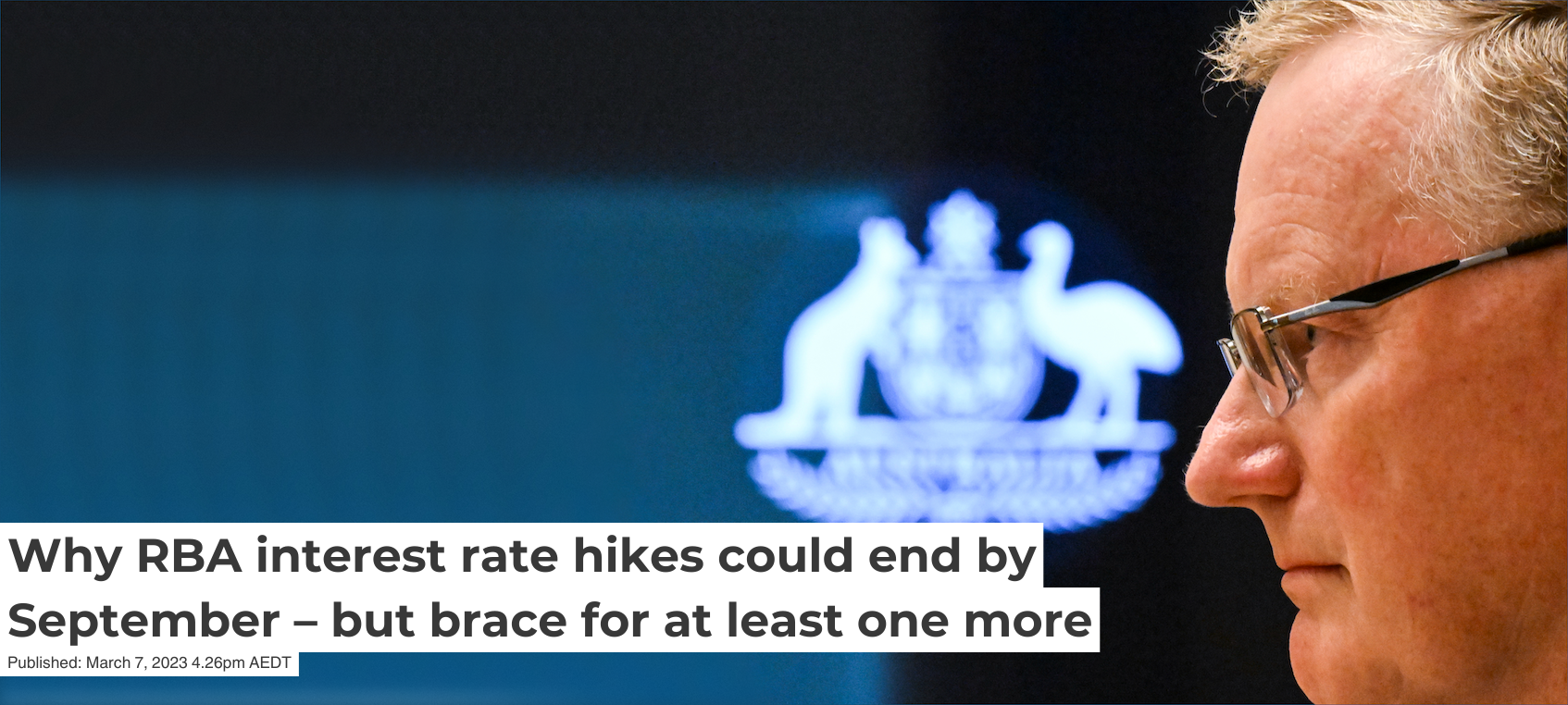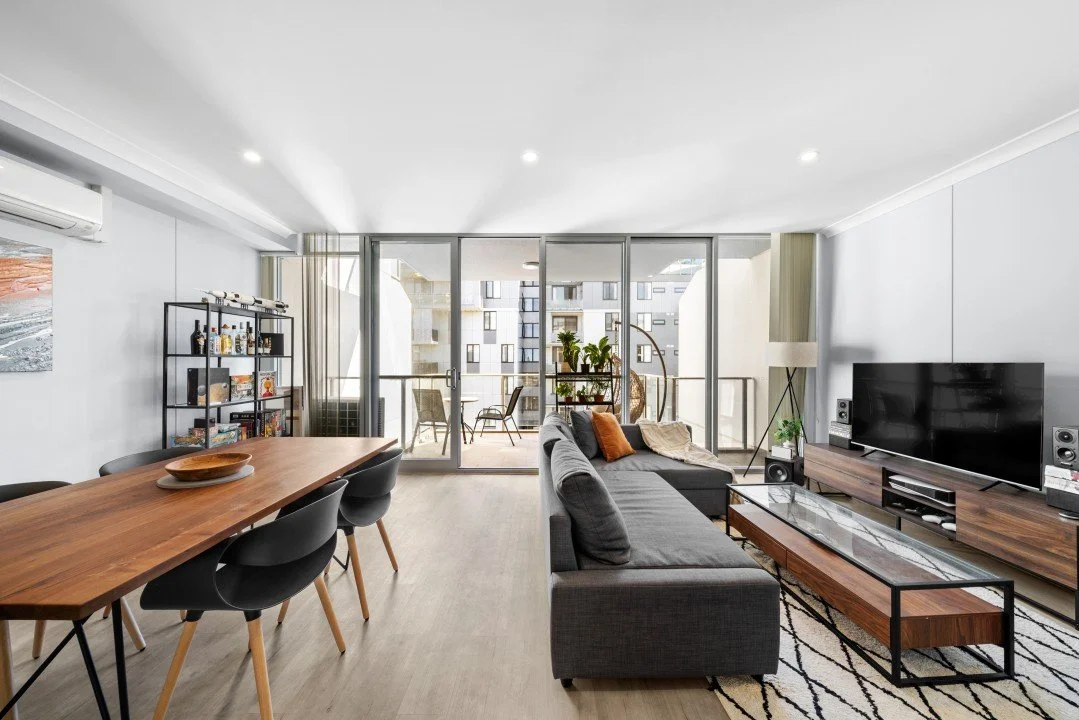Lukas Koch/AAP
Original Article by Peter Martin, Republished from The Conversation
Tuesday’s tenth successive Reserve Bank interest rate hike is the culmination of a process that has added $1,080 to the monthly cost of payments on a $600,000 variable mortgage.
I’ve calculated this increase in payments – which amounts to $12,960 per year – by comparing payments on the National Australia Bank’s base variable mortgage rate before the Reserve Bank started its series of hikes in May 2022 with payments after the NAB lifts its rates in accordance with Tuesday’s decision.
Before the Reserve Bank started hiking in May 2022, the NAB rate was 2.19%. After nine Reserve Bank hikes, ahead of Tuesday’s meeting, it was 5.24%.
It will soon be 5.49%, meaning the monthly payment on a 25-year $600,000 NAB base variable mortgage will have climbed from $2,600 to $3,680.
And Tuesday’s statement from the Reserve Bank indicates there’s more to come.
But an end to these rate rises is within sight – possibly as soon as mid-September.
Bank on at least 1 more rate rise
The best guide to what the Reserve Bank has in mind is usually the first few words of the final paragraph of its statement.
Last time, in February, those words referred to further interest rate “increases”, making it clear the bank expected more than one.
This time, there’s no plural. The sentence refers merely to “further tightening”, which could mean as little as one more increase, and not necessarily next month.
The statement, like the last, says rate hikes work “with a lag, and that the full effect of the cumulative increase in interest rates is yet to be felt in mortgage payments”. That’s a reference to the large number of borrowers who are about to be hit with higher payments as they come off low fixed rates.
And, unlike the last statement, this one says inflation may have peaked.
So there are reasons for easing off, but also – as I’ll explain shortly – important institutional forces propelling Governor Philip Lowe to keep going.
Reasons for easing off on further rate hikes
The whole point of the dramatic interest rate hikes has been to make sure Australia’s sudden reemergence of high inflation is only temporary.
Inflation hit 7.8% in December, well outside the Reserve Bank’s 2-3% target zone and the most since 1990.
The good news is to the extent that inflation comes from overseas in the prices for fuel and other imports, it seems to be easing.
US inflation has been falling for seven months now, from a high of 9.1% in June to 6.4% in January. UK inflation has been falling for three months, from 10.1% to 9.1%.
To the extent that inflation is driven by a surge in spending at home, that surge has stopped. Retail spending has been flat (unchanged) for four months notwithstanding a growing population and growing prices.
We’re winding back spending
This means what’s bought per person is falling, as would be expected if we were tightening our belts in response to higher interest rates and higher prices.
In February consumer confidence, as measured by Westpac and the Melbourne Institute, dived to its lowest point since the 2020 COVID recession.
Asked whether now was a good time to buy a major household item, only 17% of Australians surveyed said yes. Twice as many – 39% – said no.
Last week’s national accounts showed gross domestic product, the official measure of everything earned, bought and sold in the economy, climbing only 0.5% in the three months to December.
But buried in the fine print was something worse. Were it not for a fall in imports in the December quarter, GDP would have gone backwards.
Read more: RBA's latest forecasts are grim. Here are 5 reasons why
It is one of the truly bizarre mathematical oddities of the way the GDP is calculated that a fall in imports boosts measured GDP, even though it is a sign we are tightening our belts.
And we’ve been having to tighten our belts. Wage figures released since February’s board meeting show growth of just 3.3% in the year to December, way below the increase in prices, and way below the entrenched growth of 5% the governor has said would concern him.
One of the reasons wages aren’t yet climbing particularly fast is that (unusually) wage earners expect inflation to fall. Throughout most of its life, the Melbourne Institute survey of inflation expectations has pointed to higher inflation than was actually experienced. At the moment it is pointing to lower inflation.
Nevertheless, the RBA board “remains alert to the risk of a prices-wages spiral” according to Tuesday’s statement. This implies it isn’t yet reassured by the official figures and that its liaison program with 600 or so business operators has identified increases yet to come.
6 months left to leave a legacy
That’s the economics, which points to taking things gently on rate rises from here on. But as I mentioned, there’s something else at play that might propel Governor Lowe to keep going a little further.
Governor Lowe’s five-year term expires on September 17. As his predecessor did, he would like to hand over the bank in good order.
That means having clearly broken the back of runaway inflation. It might mean going harder for longer on interest rate rises than he otherwise would to get things in order. It’s what his predecessor did for him in August 2016.
Glenn Stevens cut interest rates one last time before he left office to make sure Lowe didn’t take over the bank having to do it himself. Lowe left rates unchanged for almost three years. He had been handed the keys to a car in working order.
Seen this way, Lowe’s determination to be sure inflation is on the way down before leaving office is a matter of etiquette. He has six months left to get his house in order.
It’s a consideration that might mean more mortgage rate pain than would have been the case had Lowe not been near the end of his term.
This article is republished from The Conversation under a Creative Commons license. Read the original article.
Peter Martin is Business and Economy Editor of The Conversation and a Visiting Fellow at the Crawford School of Public Policy at the Australian National University.
A former Commonwealth Treasury official, he has worked as Economics Correspondent for the ABC and as Economics Editor of The Age.
In 2016 he was made a Distinguished Alumni of Flinders University.
In 2019 He was made a member of the Order of Australia (AM).
Social sharing
Disclaimer: This article is intended to provide general news and information only. While every care has been taken to ensure the accuracy of the information it contains, neither Loanscape nor its employees can be held liable for any inaccuracies, errors or omission. All information is current as at publication release and the publisher takes no responsibility for any factors that may change thereafter. Readers are advised to contact their financial adviser, broker or accountant before making any investment decisions and should not rely on this article as a substitute for professional advice.









Loanscape has today released its Borrowing Capacity Index for Q4/2024. It confirms the forecast trend that borrowing capacities of Australian individuals and families are recovering from their low levels which coincided with the last of the recent increases to borrowing rates initiated by the Reserve Bank of Australia.